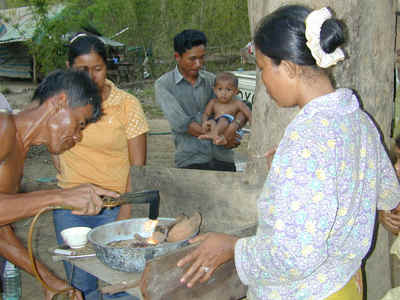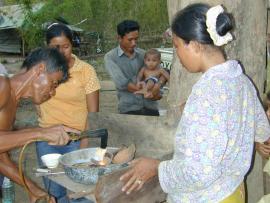Artisanal Gold Mining
Description
Artisanal and small-scale mining refers to mining activities that use rudimentary methods to extract and process minerals and metals on a small scale. Artisanal miners also frequently use toxic materials in their attempts to recover metals and gems. Such miners work in difficult and often very hazardous conditions and, in the absence of knowledge or any regulations or standards, toxic materials can be released into the environment, posing large health risks to the miners, their families and surrounding communities.1 In this context, gold mining operations are particularly dangerous, as they often use the mercury amalgamation process to extract gold from ores.
Artisanal gold mining is one of the most significant sources of mercury release into the environment in the developing world, with at least a quarter of the world’s total gold supply coming from such sources.2 Artisanal gold miners combine mercury with gold-carrying silt to form a hardened amalgam that has picked up most of the gold metal from the silt. The amalgam is later heated with blowtorches or over an open flame to evaporate the mercury, leaving small gold pieces. The gaseous mercury is inhaled by the miners and often by their immediate family, including their children. Mercury that is not inhaled during the burning process, settles into the surrounding environment or circulates globally for future deposition far from the site, where it is absorbed and processed by a variety of living organisms. This transforms elemental mercury into methylmercury. Methylmercury is one of the most dangerous neurotoxins that contaminate the food chain through bioaccumulation.
Context
Most artisanal gold miners are from socially and economically marginalized communities, and turn to mining in order to escape extreme poverty, unemployment and landlessness.3 The dangers force miners to not only risk persecution by the government, but also mine shaft collapses, and toxic poisoning from the variety of chemicals unsafely used in processing. Despite the many dangers of this activity, artisanal mining operations continue to spread as the demand for metals increases and other livelihoods such as farming, are no longer economically viable.
UNIDO estimates that mercury amalgamation from this kind of gold mining results in the release of an estimated 1000 tons of mercury per year, which constitutes about 30% of the world’s anthropogenic mercury emissions. It is estimated that between 10 and 15 million artisanal and small scale gold miners worldwide, including 4.5 million women and 600,000 children.4 According to UNIDO, as much as 95 percent of all mercury used in artisanal gold mining is released into the environment, constituting a danger on all fronts – economic, environmental and human health.5
Exposure Pathways
Artisanal gold mining releases mercury into the environment in its metallic form during amalgamation and as mercury vapor during the burning process. When metallic mercury is used to concentrate the gold, small amounts can be washed out along with the unwanted tailings or sediments. One study estimates that one or two grams of metallic mercury is lost for every gram of gold produced using the amalgamation process.6 Once mercury is released into waterways, it enters the food chain through the digestion of bacteria and becomes far more toxic– methylmercury. Methylmercury bioaccumulates in the food chain and is ingested by residents of downstream communities as they eat contaminated fish. The most direct pathway however, is the inhalation of mercury vapors created during the burning process. An immediate toxic exposure, miners and their families are most affected by these noxious vapors. A study of artisanal gold mining in Peru concluded that for every gram of gold that is produced, at least two grams of mercury are emitted into the atmosphere.7
Health Effects
Children that are exposed to mercury are particularly at risk for developmental problems. Exposure to mercury can cause kidney problems, arthritis, memory loss, miscarriages, psychotic reactions, respiratory failure, neurological damage and even death.
Some sites that have been noted as examples of the problem
The Blacksmith Institute has initiated a series of appropriate technology demonstrations to limit mercury emissions associated with small-scale mining, involving the use of retort technology to reduce mercury vapors and enable recapture of mercury from the amalgam for reuse. These programs are carried out in conjunction with UNIDO’s Global Mercury Project. Such programs can be very effective at the community level, although they are labor intensive to implement and challenging to replicate.
Footnotes
1 Hilson, Gavin; Hilson, Christopher J.; and Pardie, Sandra. “Improving awareness of mercury pollution in small-scale gold mining communities: Challenges and ways forward in rural Ghana.” November 13, 2006.
2 Veiga, M.M., et al. (2005). Pilot Project for the Reduction of Mercury Contamination Resulting From Artisanal Gold Mining Fields in the Manica District of Mozambique
3 Tschakert, Petra and Singha, Kamini. “Research on Smal-Scale Gold Mining in Ghana.” Pennsylvania State University: Department of Geography. October 11, 2006. Available at http://www.geog.psu.edu/news/petra_ghana.html
4 Veiga, M.M., Baker, R. (2004). Protocols for Environmental and Health Assessment of Mercury Released by Artisanal and Small Scale Miners, Report to the Global Mercury Project: Removal of Barriers to Introduction of Cleaner Artisanal Gold Mining and Extraction Technologies
5 Veiga, M.M., et al. (2005). Pilot Project for the Reduction of Mercury Contamination Resulting From Artisanal Gold Mining Fields in the Manica District of Mozambique
6 Timmins, Kerry J. “Artisanal Gold Mining without Mercury Pollution.” United Nations Industrial Development Organization. UNIDO. January 31, 2003. Available at http://www.natural-resources.org/minerals/cd/docs/unido/asm_mercury.pdf
7 “Slum at the Summit.” Earth Report. Television Trust for the Environment. Accessed on September 15, 2008. Available at http://www.tve.org/earthreport/archive/doc.cfm?aid=1623
Additional Resources
Artisanal Gold Mining (word doc)
Additional Photos
| An artisanal gold miner holds mercury amalgam in her palm. Senegal. Photo by Blacksmith Institue. |
|
|
Artisanal gold mining in action. Senegal. Photo by Blacksmith Institute. |
|
 |
Burning off mercury puts the lives of miners and their famlies in danger. Thailand. Photo by Blacksmith Institute. |




